Key Takeaways
- Researchers wanted to see if training each muscle group more frequently each week would lead to more muscle growth.
- They found that when you look at all of the best studies, the people who train 3 times per week usually gain more muscle than the people who train 1 to 2 times per week, but the improvements were small.
- If you have a lagging muscle group that you want to develop, you’ll probably make faster gains if you train it 2 or 3 times per week instead of once per week.
There are a lot of ways to mess up your training plan.
Not using heavy enough weights.
Not doing the big, compound lifts.
Not resting enough between sets.
And finally, training too much or not enough.
That last mistake is one of the most controversial.
Old school bodybuilding logic says you should “blast” every muscle group with as many sets and reps as you can handle once per week, then rest 6 days before doing it again.
Others say you should train every muscle group 2, 3, or 4 times per week, but with much lower volumes.
There are countless success stories to back up both camps, so who are you supposed to believe?
That’s what a group of scientists led by Brad Schoenfeld of Lehman College wanted to find out in a recent study.
Let’s look at what they found.
- What Did the Researchers Do?
- What Were the Study Results?
- What Does This Mean for You?
Table of Contents
+What Did the Researchers Do?

There have been a decent number of studies looking at how training a muscle group more or less often affects muscle growth.
And most have been a wash, with no difference between groups.
So, these researchers decided to take a step back, look at all of the data on this topic, and try to tease out which way the body of evidence seemed to be pointing.
This kind of study is known as a meta-analysis, because it looks at a problem from a “meta,” or higher level perspective.
The main benefit of a meta-analysis is that by lumping together the results of multiple studies, you can spot trends that might otherwise be obscured in smaller studies with fewer subjects.
In this meta-analysis, the scientists narrowed down their list of studies to ones that…
- Involved training plans that directly compared different weekly frequencies and didn’t change too many other variables like volume, intensity, and exercise choices.
- Used healthy humans instead of lab animals.
- Were at least 4 weeks long, which gives the subjects time to gain a decent amount of muscle.
- Measured muscle growth in multiple ways to get more accurate results.
- Used compound exercises, so the training plans were similar to what people do in the gym.
After the researchers combed through the data, they found 10 studies that fit the bill. In every case, both groups used the same exercises, volumes, and reps, and rested the same amount between sets.
The only difference was that some people were put on a training plan that spread that volume over more days per week, and some people were put on a training plan that spread that volume over fewer days per week.
Then, the researchers (including a member of our Scientific Advisory Board and statistical wizard, James Krieger), ran the studies through a variety of equations to ensure the results were accurate.
What Were the Study Results?
People who spread their weekly training volume over 3 days per week gained more muscle than people who spread their weekly training volume over 1 to 2 days per week.
On average, training a muscle group 3 times per week resulted in 3.1% greater muscle growth than training 1 or 2 times per week (6.8 vs 3.7 %).
Over 8 weeks of training, that would work out to about an extra 1/8th of a pound of muscle for someone new to strength training.
That adds up over time, but it’s not a huge difference.
Here’s what the results look like when you organize the study subjects into different groups:

There are two ways to look at this:
- You can build more muscle in the same amount of time just by training each muscle group more frequently. Why wouldn’t you do it? Adoy!
- You can only build a tiny bit more muscle by training each muscle group more frequently, so why bother?
When we look closer at the results, there are also a few caveats that make the results even less cut and dry.
- Five of the studies were on people who hadn’t lifted weights for at least a year. Of these five studies, 2 were on middle-aged adults (30 to 49 years old) and 2 were on elderly women (50+ years old). While people don’t differ that much in how they respond to strength training, the results are less relevant if you don’t fall into one of those groups.
- The studies used a variety of different training frequencies, which makes it impossible to say which is “best.” Some compared training 1 to 2 days per week, some compared training 2 to 3 days per week, and others compared training 1 to 3 days per week.
With such a small improvement, it’s hard to say that higher frequency training is a home run for muscle growth.
But, here’s some food for thought:
All of the groups in this study did the same amount of volume.
On the one hand, it means that we know the differences in muscle growth weren’t because one group was doing more volume than the other group.
On the other hand, the main reason people agitate for higher training frequencies is because they allow you to squeeze more volume into each week.
It’s well established that doing more sets per week usually leads to more muscle growth, so if training more often helps you get more volume, it’s not a leap to say that it should help you build muscle.
For example, let’s say you currently do 6 sets of bench press once per week. By the 4th, 5th, and 6th set, you’re probably starting to get bushed. You might even have to decrease the weight.
What if you split those 6 sets into 2 workouts per week, though?
Then, you’d do 3 sets per workout, and probably be able to use more weight during each set.
You could take things a step further and add 1 set to each workout, thus increasing your total weekly volume to 8 sets per week.
In other words, it’s not training more frequently that helps you build muscle, per se, but training more frequently so that you can do more volume, that gives you more gains.
That’s the theory, anyway, but this study didn’t look at that.
Something else to consider is that all of the studies included in this meta-analysis originally found no benefit of training more frequently. When the results were added together, though, there was a statistically meaningful increase in muscle growth.
This is a common theme in scientific research.
Small studies don’t find any benefit, but when you get a large enough sample size you can find a clear winner, which suggests there might have been some “hidden” benefits all along.
In the final analysis, here’s what the researchers concluded:
It can be inferred that the major muscle groups should be trained at least twice a week to maximize muscle growth. Due to an absence of data, it is not clear whether training muscle groups more than 3 days per week might enhance the hypertrophic response.
What Does This Mean for You?

Training each muscle group twice per week can help you gain more muscle than training each muscle group once per week.
Before you throw away your current training plan, keep the following in mind:
- Training more frequently probably is better, but not that much better. We’re talking a few percentage points difference. Sure, that adds up over time, but it might not be a good idea to change your current plan if it’s working.
- It’s likely that the main benefit of training more frequently is that it lets you use higher training volumes. If you decide to train each muscle group more frequently, think about doing 1 or 2 extra sets to your main lifts to get the most muscle-building benefits.
- If you have a lagging muscle group (usually arms, shoulders, and chest for guys, and legs and butt for women), then you should think about training that muscle group 3 times per week.
In terms of programming your workouts, this doesn’t mean you need to have a dedicated workout for each muscle group. Instead, you could have one primary workout for a major muscle group, and then train that same muscle group on a different day after training another muscle group.
For example, you could have a dedicated chest workout on Monday, and then do a few sets of chest after hitting your shoulders on Thursday.
This lets you train each muscle group about twice per week, without spending too much time in the gym.
Many popular strength training plans are built on this model, including Bigger Leaner Stronger and Thinner Leaner Stronger.
If you want to give this kind of training a test drive, we’ve got you covered.
Follow one of the following workout routines below for 12 weeks …
The Absolute Best Biceps Workout: 5 Biceps Exercises That Build Big Guns
The Absolute Best Triceps Workout: 5 Triceps Exercises That You Should Be Doing
How to Create the Ultimate Upper Chest Workout
The Best Back Exercises to Build Your Best Back Ever
The Best Shoulder Workouts for Men & Women
The 7 Best Butt Exercises That Will Give You Glorious Glutes
The 6 Absolute Best Quads Exercises You Can Do
The 6 Best Hamstring Exercises You Need to Do
… and let us know how it goes in the comments below. 🙂
What’s your take on how often you should work out? Have anything else to share? Let me know in the comments below!
Scientific References +
- JW, K. (2010). Single vs. multiple sets of resistance exercise for muscle hypertrophy: a meta-analysis. Journal of Strength and Conditioning Research, 24(4), 1150–1159. https://doi.org/10.1519/JSC.0B013E3181D4D436
- BJ, S., D, O., & JW, K. (2016). Effects of Resistance Training Frequency on Measures of Muscle Hypertrophy: A Systematic Review and Meta-Analysis. Sports Medicine (Auckland, N.Z.), 46(11), 1689–1697. https://doi.org/10.1007/S40279-016-0543-8










